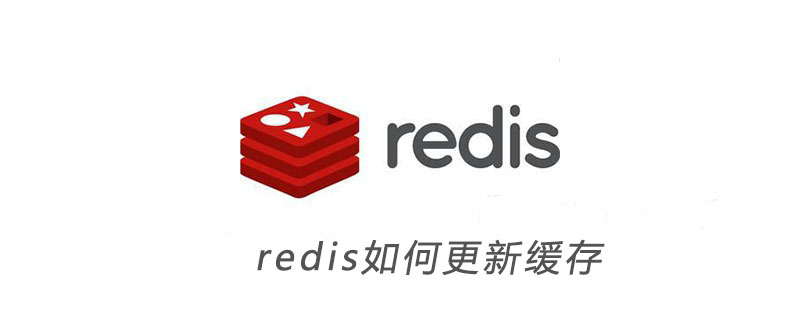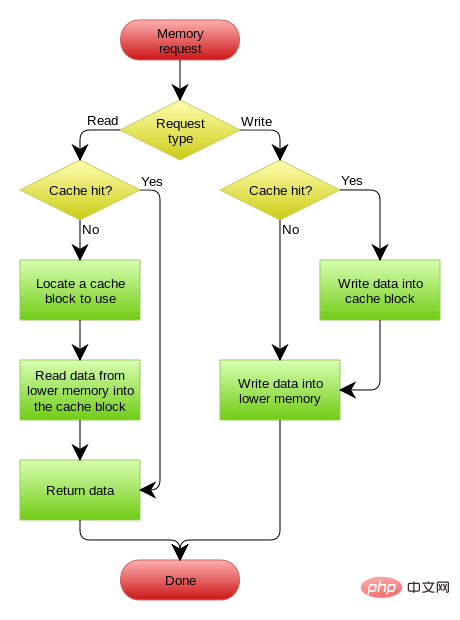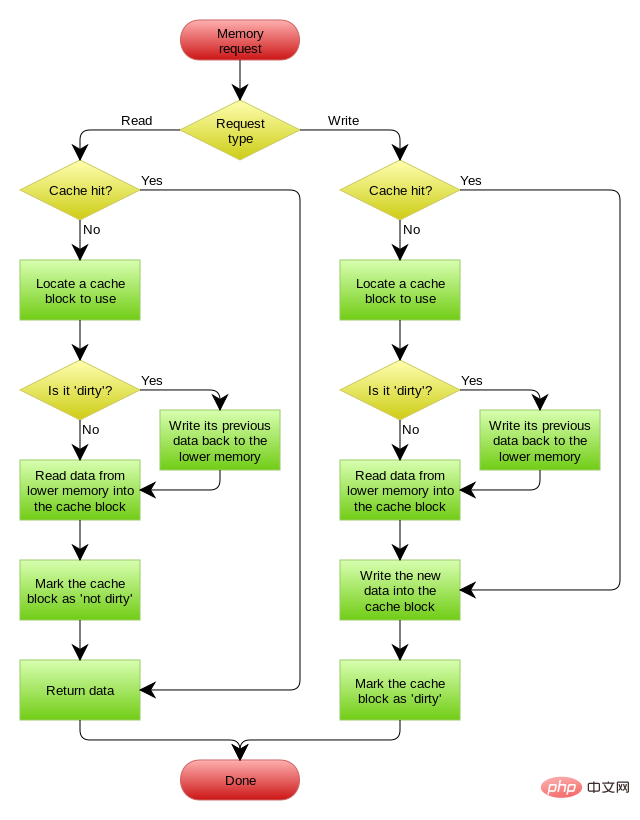How redis updates cache
There are four Design Patterns for redis to update the cache: Cache aside, Read through, Write through, Write behind caching. Let’s take a look at these four Patterns one by one.

Cache Aside Pattern
This is the most commonly used pattern. The specific logic is as follows: (Recommended learning: Redis video tutorial)
Invalidation: The application first gets the data from the cache. If it does not get it, it will get the data from the database. After success, , put into the cache.
Hit: The application fetches data from the cache and returns after fetching it.
Update: First save the data into the database, and then invalidate the cache after success.
Note that our update is to update the database first, and then invalidate the cache after success. So, can this method avoid the problem mentioned earlier in the article? We can figure it out.
One is the query operation, and the other is the concurrency of the update operation. First of all, there is no operation to delete the cache data, but the data in the database is updated first. At this time, the cache is still valid, so concurrency The query operation takes data that has not been updated.
However, the update operation immediately invalidates the cache, and subsequent query operations pull the data out of the database. Unlike the logic problem at the beginning of the article, subsequent query operations will always fetch old data.

Read Through
Read Through routine is to update the cache during the query operation, that is, when the cache expires (expiration or LRU swap out), Cache Aside is the caller's responsibility to load the data into the cache, while Read Through uses the cache service to load it itself, so it is transparent to the application.
Write Through
Write Through routine is similar to Read Through, but it occurs when data is updated. When data is updated, if the cache is not hit, the database is directly updated and then returned. If the cache is hit, the cache is updated, and then the Cache itself updates the database (this is a synchronous operation)
The picture below comes from Wikipedia's Cache entry. You can understand the Memory as the database in our example.

Write Behind Caching Pattern
Write Behind is also called Write Back. Some students who know the Linux operating system kernel should be very familiar with write back. Isn't this the Page Cache algorithm of the Linux file system? Yes, you see the basics are all the same. Therefore, the foundation is very important. I have said this not once before.
Write Back routine, in a nutshell, when updating data, only the cache is updated, not the database, and our cache will update the database asynchronously in batches.
The advantage of this design is that the data I/O operations are extremely fast (because the memory is directly operated). Because of the asynchronous write backg, write backg can also merge multiple operations on the same data, so the performance improvement is Quite impressive.
However, the problem it brings is that the data is not strongly consistent and may be lost (we know that abnormal shutdown of Unix/Linux will cause data loss, because of this).
In software design, it is basically impossible for us to make a design without defects, just like time is exchanged for space in algorithm design, and space is exchanged for time. Sometimes, strong consistency and high performance, High availability and high performance are in conflict. Software design has always been about trade-off.
In addition, the implementation logic of Write Back is relatively complex, because it needs to track which data has been updated and needs to be flushed to the persistence layer. The write back of the operating system will be truly persisted only when the cache needs to be invalidated, for example, when the memory is not enough, or the process exits, etc. This is also called lazy write.
There is a flow chart of write back on wikipedia. The basic logic is as follows:

For more Redis related technical articles, please visit Getting Started with Redis Learn in the tutorial column!
The above is the detailed content of How redis updates cache. For more information, please follow other related articles on the PHP Chinese website!

Hot AI Tools

Undresser.AI Undress
AI-powered app for creating realistic nude photos

AI Clothes Remover
Online AI tool for removing clothes from photos.

Undress AI Tool
Undress images for free

Clothoff.io
AI clothes remover

Video Face Swap
Swap faces in any video effortlessly with our completely free AI face swap tool!

Hot Article

Hot Tools

Notepad++7.3.1
Easy-to-use and free code editor

SublimeText3 Chinese version
Chinese version, very easy to use

Zend Studio 13.0.1
Powerful PHP integrated development environment

Dreamweaver CS6
Visual web development tools

SublimeText3 Mac version
God-level code editing software (SublimeText3)

Hot Topics
 1387
1387
 52
52
 How to build the redis cluster mode
Apr 10, 2025 pm 10:15 PM
How to build the redis cluster mode
Apr 10, 2025 pm 10:15 PM
Redis cluster mode deploys Redis instances to multiple servers through sharding, improving scalability and availability. The construction steps are as follows: Create odd Redis instances with different ports; Create 3 sentinel instances, monitor Redis instances and failover; configure sentinel configuration files, add monitoring Redis instance information and failover settings; configure Redis instance configuration files, enable cluster mode and specify the cluster information file path; create nodes.conf file, containing information of each Redis instance; start the cluster, execute the create command to create a cluster and specify the number of replicas; log in to the cluster to execute the CLUSTER INFO command to verify the cluster status; make
 How to clear redis data
Apr 10, 2025 pm 10:06 PM
How to clear redis data
Apr 10, 2025 pm 10:06 PM
How to clear Redis data: Use the FLUSHALL command to clear all key values. Use the FLUSHDB command to clear the key value of the currently selected database. Use SELECT to switch databases, and then use FLUSHDB to clear multiple databases. Use the DEL command to delete a specific key. Use the redis-cli tool to clear the data.
 How to read redis queue
Apr 10, 2025 pm 10:12 PM
How to read redis queue
Apr 10, 2025 pm 10:12 PM
To read a queue from Redis, you need to get the queue name, read the elements using the LPOP command, and process the empty queue. The specific steps are as follows: Get the queue name: name it with the prefix of "queue:" such as "queue:my-queue". Use the LPOP command: Eject the element from the head of the queue and return its value, such as LPOP queue:my-queue. Processing empty queues: If the queue is empty, LPOP returns nil, and you can check whether the queue exists before reading the element.
 How to use the redis command
Apr 10, 2025 pm 08:45 PM
How to use the redis command
Apr 10, 2025 pm 08:45 PM
Using the Redis directive requires the following steps: Open the Redis client. Enter the command (verb key value). Provides the required parameters (varies from instruction to instruction). Press Enter to execute the command. Redis returns a response indicating the result of the operation (usually OK or -ERR).
 How to use redis lock
Apr 10, 2025 pm 08:39 PM
How to use redis lock
Apr 10, 2025 pm 08:39 PM
Using Redis to lock operations requires obtaining the lock through the SETNX command, and then using the EXPIRE command to set the expiration time. The specific steps are: (1) Use the SETNX command to try to set a key-value pair; (2) Use the EXPIRE command to set the expiration time for the lock; (3) Use the DEL command to delete the lock when the lock is no longer needed.
 How to read the source code of redis
Apr 10, 2025 pm 08:27 PM
How to read the source code of redis
Apr 10, 2025 pm 08:27 PM
The best way to understand Redis source code is to go step by step: get familiar with the basics of Redis. Select a specific module or function as the starting point. Start with the entry point of the module or function and view the code line by line. View the code through the function call chain. Be familiar with the underlying data structures used by Redis. Identify the algorithm used by Redis.
 How to solve data loss with redis
Apr 10, 2025 pm 08:24 PM
How to solve data loss with redis
Apr 10, 2025 pm 08:24 PM
Redis data loss causes include memory failures, power outages, human errors, and hardware failures. The solutions are: 1. Store data to disk with RDB or AOF persistence; 2. Copy to multiple servers for high availability; 3. HA with Redis Sentinel or Redis Cluster; 4. Create snapshots to back up data; 5. Implement best practices such as persistence, replication, snapshots, monitoring, and security measures.
 How to use the redis command line
Apr 10, 2025 pm 10:18 PM
How to use the redis command line
Apr 10, 2025 pm 10:18 PM
Use the Redis command line tool (redis-cli) to manage and operate Redis through the following steps: Connect to the server, specify the address and port. Send commands to the server using the command name and parameters. Use the HELP command to view help information for a specific command. Use the QUIT command to exit the command line tool.




